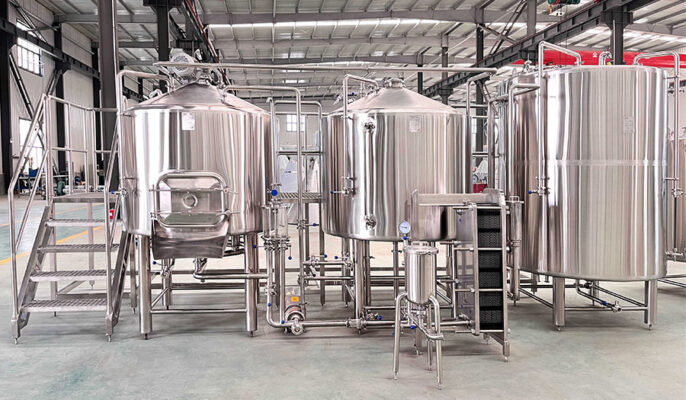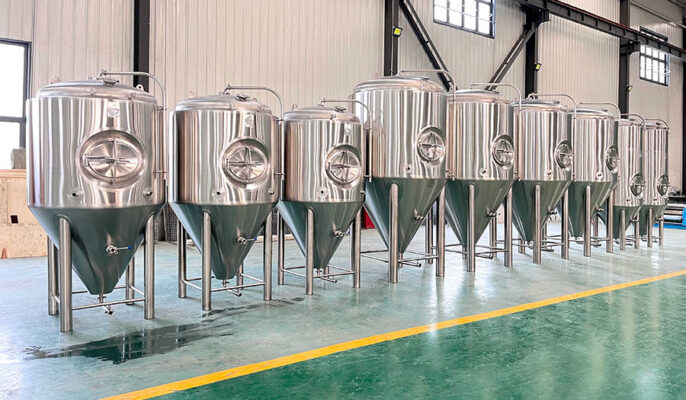Starting a craft brewery is a dream for beer lovers and brewers alike, but it’s anything but simple. To ensure the success of your craft brewery, it is crucial to make informed decisions about the equipment you invest in. From choosing the right brewing system and fermenters to choosing the necessary kegging and packaging machinery, this guide gives you the knowledge you need to know about your craft brewery equipment.
What is craft brewery equipment?
The craft brewery equipment saccharification system also includes filter barrels, current generators, malt grinders, wort pumps, and plate heat exchangers. Yeast is fermented in the fermentation tank, and other fermentation ingredients are added through yeast addition equipment and cooling pumps. Brewing requires a lot of different equipment, and you need all it to be successful.
The following is a list of craft brewery equipment:
- Brewery
- Grain mill
- Water treatment machine
- Fermentation tank
- Bright tank
- Steam boiler
- Filtration system
- Heat exchanger
- wort pump
- Ethylene glycol cooling system
- CIP cleaning system
- PID semi-automatic control system
- Packaging equipment
- Some brewery equipment accessories

Malt grinding in craft breweries
A malt grinder is an important piece of equipment used to grind malt and barley used in the production of beer. This machine uses its sharp burrs to grind malt and turn it into malt powder, which is then used to brew beer. The finer the malt is ground, the greater the potential for delicious beer. A malt mill is an important piece of equipment for any brewery that wants to brew beer.
Brewery Equipment in Craft Brewery Equipment
Brewing kettle
The brew kettle is an important part of a craft brewery setup as it is where the wort is boiled along with hops and other ingredients to make the final beer. The boiling process is crucial because it helps sterilize the wort, extract flavor and aroma from the hops, and remove unwanted compounds.
There are many types of brewing kettles, including hot pots, steam kettles, and electric kettles. Direct-fire kettles are the most common type because they are easy to use and offer precise temperature control. Steam kettles are another option and are preferred for larger breweries as they provide more consistent heating. Cost-effective and easy to use, electric kettles are ideal for small breweries or home brewing.
Mash/filter barrel
The mash/lautering tun is a key component of any craft brewery setup as it is where the brewing process begins. Craft breweries use several types of mash/lautering tuns, including steeping tuns, decoction tuns, and mash tuns. Infusion kegs are the most common type because they are simple to use and ideal for small to medium-sized breweries. Decoct tuns are used for more complex brewing processes, while mash tuns are better suited for larger breweries.
The size and shape of the mash/lautering barrel can also vary depending on the brewer’s needs. Some craft breweries use stainless steel kegs, while others prefer wooden or plastic kegs. , mash/lautering barrel selection will depend on the size of your craft brewery, your brewing process, and your personal preferences.
Fermentation tanks in craft brewery equipment
After the brewing process is complete, the wort is transferred to the fermenter, yeast is introduced and the fermentation process begins. A beer fermenter is a vessel where wort is converted into alcohol, allowing your beer to ferment at a controlled temperature. Conical fermenters make it easier to capture yeast because the yeast can be reused. For the establishment of a craft brewery, the fermentation tank is one of the most important pieces of equipment. You need to choose a more suitable fermentation tank based on the daily output of your craft brewery.
Bright tank
A bright tank is a pan-bottom pressure-rated temperature-controlled tank used to hold beer in preparation for packaging. The term “bright” refers to “bright beer”, i.e. beer made bright (clear) by filtration, centrifugation, clarification, and/or aging. In most breweries, the beer will be filtered after leaving the single tank or beer tank and directed into a bright tank. If you want to force carbonate your beer, you can carbonate it online under pressure between a fermenter or beer tank and a bright tank.
Beer filtration system
The filtration system consists of a filter pump and a filter tank. It is an optional craft brewery equipment for breweries to drop residual particles and sediment. After filtering, what’s left is a smooth finished beer.
Beer filtration is the process of removing solid particles, yeast, and other impurities remaining in beer after brewing. Many beer types rely on the clear, golden transparency of beer as part of their brand recognition. Filtration is not only used to clarify beer. It is also used to purify beer and make it sterile. Many processes in beer production focus on sterilization and purification, and filtration is one of them.

CIP cleaning system
The CIP cleaning system is used to clean in-place brewery equipment such as pipes, storage tanks, filling machines, heat exchangers, etc. Cleaning time, temperature, pressure, and flow are adjustable, ensuring optimal results to suit the brewery’s needs. In the beer brewing process, besides to technical methods, the most important thing is the issue of cleanliness. The conditioning and storage of beer during brewing are carried out in large stainless steel tanks that must be cleaned . If not cleaned , the quality of the beer cannot be guaranteed.
Packaging system
Depending on how your craft brewery handles its final product, packaging equipment may not be necessary. Filling machines are used to fill products into bags, sachets, or containers such as buckets or bottles. At the end of the production process, most goods are measured in specified quantities and packaged in bags or containers before being sold in the market. Bottle or can systems ease the distribution of your beer.
Keg filling requires the equipment and storage space to fill and charge the kegs for distribution to local restaurants and bars. This also brings you one step closer to offering kegs to your brewery’s patrons. Make a quality keg system a priority and make sure there is enough space to store the keg at cool temperatures before distribution. Beer filling machine is a device used to package and fill beer liquid into containers. Maximize product filling efficiency and accuracy while minimizing waste.
Advantages of craft beer equipment
- Customization: Craft beer equipment gives brewers greater control over the brewing process, allowing them to customize the taste, aroma, and characteristics of their beer. This allows for more creativity and experimentation when brewing unique and unique beer styles.
- Small-scale production: Craft beer equipment is designed for small and medium-sized production, ideal for small breweries, beer bars, or home breweries. This makes it more flexible to produce small-batch beers, useful for testing and refining recipes, as well as catering to local or niche markets.
- Quality and freshness: Craft beer equipment often emphasizes the use of high-quality raw materials and meticulous brewing techniques, resulting in beer with superior taste and freshness compared to mass-produced beer. Craft beer equipment allows for greater attention to detail in the brewing process, resulting in higher-quality beer.
- Cost-Effectiveness: Craft beer equipment is more cost-effective for small-scale production than large-scale commercial beer equipment, which is often more expensive. Craft beer equipment offers a more affordable option for breweries starting on a smaller scale or with a limited budget.
- Sustainability: Craft beer equipment can be designed with sustainability in mind, with options for energy-saving brewing methods, water conservation, and waste reduction. This aligns with the values of many craft brewers, who focus on environmental sustainability and social responsibility in their brewing practices.
How to choose craft brewery equipment?
- Output: The first choice is to determine your output and know exactly how much beer you brew at a specific time.
- Available space: Assess or plan the physical space and consider ceiling heights and access points for installation, maintenance, and potential future expansion. The layout of the space will affect the size and configuration of the brewing equipment,
- Brewing process and batch size: Test your brewing process and determine the typical batch size you plan to produce. Whether you focus on small-batch processes or opt for larger batches, tailor your equipment selections to your brewing style, recipe complexity, and the number of fermenters and storage vessels required.
- Scalability: Consider your craft brewery’s long-term plans. Choose brewing equipment that is scalable and can accommodate increased production.




